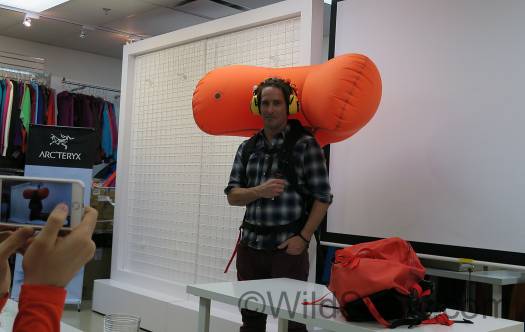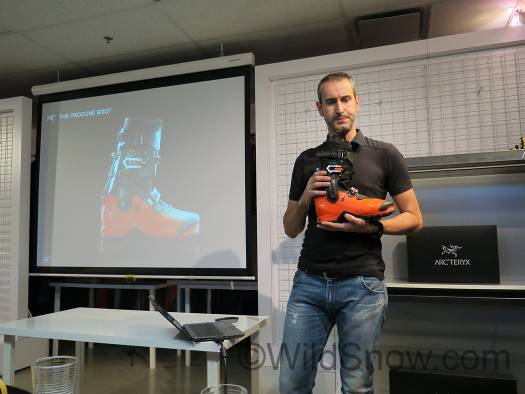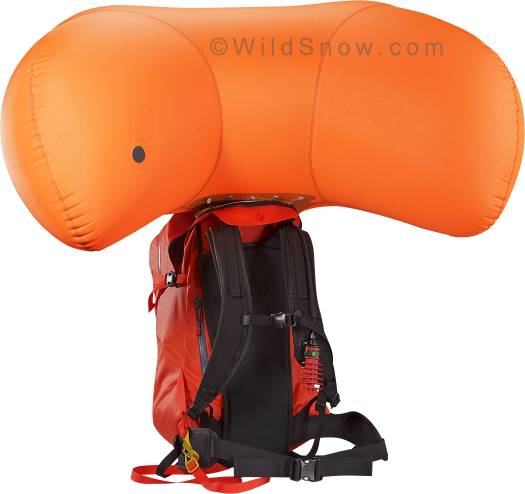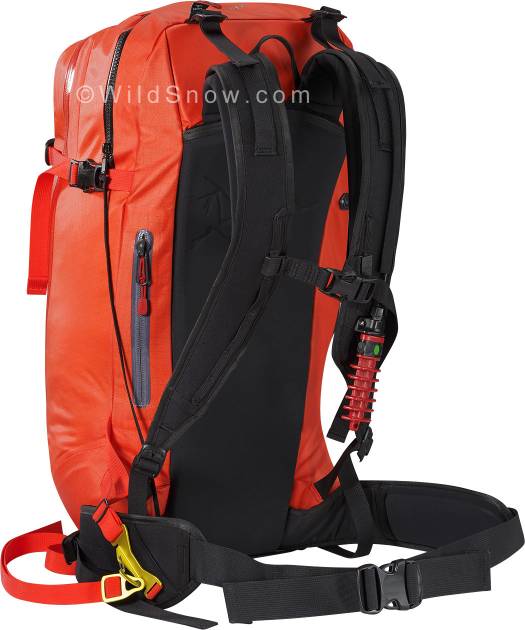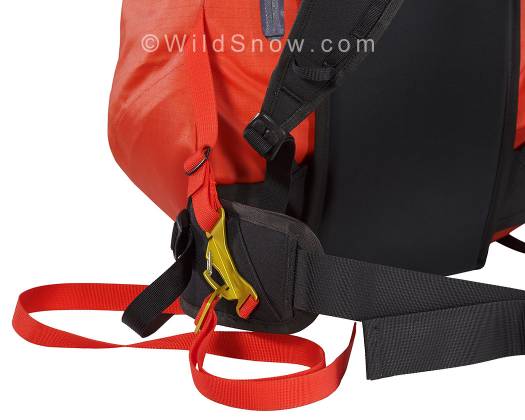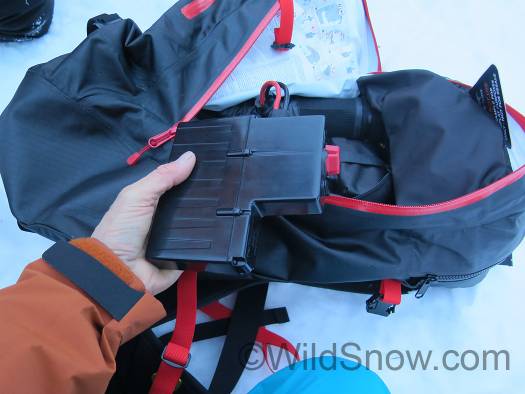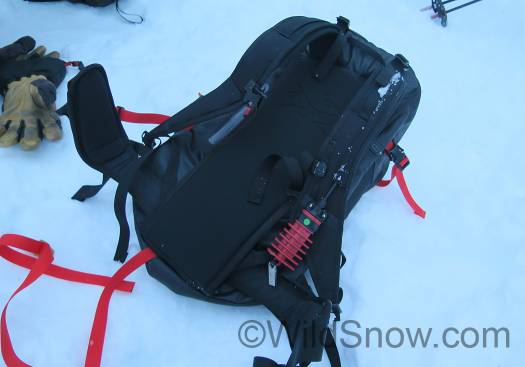I’m up here in Vancouver, Canada covering what Arcteryx is calling their biggest product launch ever — by a factor of “five.” I’ll get into the clothing some other time, for now I’m blasting up a blog post just to get this out there for all you gearheads. They’re keeping us too busy, but I’ll update this post with more details and photos over the next 12 hours.
The Voltair electric fan avalanche airbag backpack (available next winter of 2016/2017) comes in two sizes with “true volume, measuring what’s left AFTER the airbag guts are taken out of the equation.” Both the 20 liter and 30 liter versions appear to live up to that, as they’re quite commodious. They weigh 7.1 nd 7.6 pounds respectively. The fan system appears to work quite nicely, blowing the 150 liter balloon up to taut pressure in 5 seconds or a bit less. Standout features include a snappy leg loop system I very much like, and a mechanical triggering system (basic housed cable) that’s intuitive, with a handle that’s an easy grab and pull. The plumbing uses an impeller with a centrifugal blower, said to be difficult to engineer but able to provide excellent pressure as well as volume.
A rather large battery yields the juice for many Voltair inflations at normal winter temperatures, and insures at least a couple of puffs in arctic refrigeration. As always, we’d sure like to see a smaller battery — but they’ve got to keep it working up to standards. No worries, near as I can tell you could swap in a smaller 22.2 volt battery sourced from the RC race car hobby circuit. I feel my mod a growin’!
The marketing push for Voltair includes interesting (and valid) wrinkles. For example, they’re emphasizing that a percentage of avalanche deaths may be caused by people failing to deploy their airbags. Solution: As emergency personal do, any airbag user should do repetitive training for pulling the trigger, so they don’t freeze up in a real situation. You really can’t do that with a compressed gas system — it is simply to much hassle to keep recharging your tank. Electric, trivial. Just recharge and keep practicing until you pull the trigger subconsciously at the slightest hint of a slide.
I didn’t notice any immediate downsides to this version of the fan pack. Weight is a little higher than I expected (3465 gr, 7.6 lbs for the 30 liter). I’ve studied this issue quite a bit now. The weight problem resides in the batteries. Due to the need for high pressure inflation in 5 seconds or less, at temperatures down to negative 30 centigrade (these types of batteries are quite temperature sensitive), retail versions of these electric packs have to be sold with a massive lithium battery. I think the aftermarket can eventually step in on this and sell smaller swap-in batteries specified for a higher temperature range and fewer fills from one charge, but until then we’re stuck hauling around an 800 gram brick.
Aparantly, other battery technologies are available but nothing beats the basic 22.5 volt lithium polymer in terms of cost/reliability/capacity/weight. For example, a D-cell sized “thermal cell” exists that would inflate an airbag rucksack. Problem is it costs $700. The consensus on all this seems to be that first we simply need better batteries, and second we need more data about real life temperatures so we could avoid hauling around 500 or so grams of redundant power.
Interestingly, Arcteryx built “black box” data recording into the Voltair controller and battery electronics. With user permission they can downlink a full data set, including battery temperatures. Apparently they’ve been recording their test unit battery temps in the field, then comparing to ambient air temperatures, to ascertain exactly how cold the batteries become during different types of use (e.g., quick day trip vs overnight in a tent). One of the designers told me they’d indeed experimented with battery insulation and electric warming, but such tweaks added more weight than simply using a larger battery. He also told me that the battery does stay slightly warmer due to body heat, but only a by a few degrees and of course only if the pack is on your torso.
I think the new Procline boot blew me away more than the airbag blower (even though the fan is so loud you should wear ear protection for testing). These boots may be a category breaker. Design philosophy is a shoe that skis — but also climbs — as in rock and ice. This is accomplished by the usual suspects, such as extreme cuff articulation and light weight. But with an added twist that is literally, a twist.
The Procline cuff attached to the cuff pivots is actually two pieces instead of the usual one. When you unlatch into touring/walking mode, the left and right sides of the cuff add noticeable flex for natural left-right ankle roll. It’s Almost like being in a hiking or alpine climbing boot, only with a bit more limited travel so you still have support when you need it. Idea is when skinning uphill, you can keep your skis much flatter on the snow when desired, with much more natural movements while doing kick turns. Sounds a bit out there, but I think these things might actually work, I’ll find out tomorrow. They feel amazing in carpet testing, like a top quality lightweight ski touring boot when locked up, and yes, you can walk around like you’re in a pair of hiking boots.
I was interested in how long it took to develop these, so I asked, Federico Sbrissa, who is the Product Line Manager for Arcteryx. He told me they started on the project around 2013, and got serious about the “split cuff” patent in June of 2014. Thus, basically a four year project. For a ski touring boot that’s quite different, that seems like a quick roll.
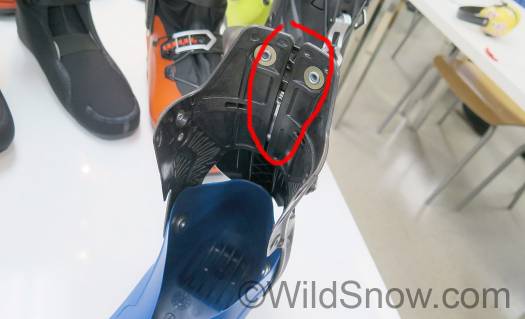
Procline ‘split’ cuff is an ingenious way to allow rolling movement of your ankle while unlocked. The two sides simply bend outward, it’s like ‘why didn’t I think of that?’
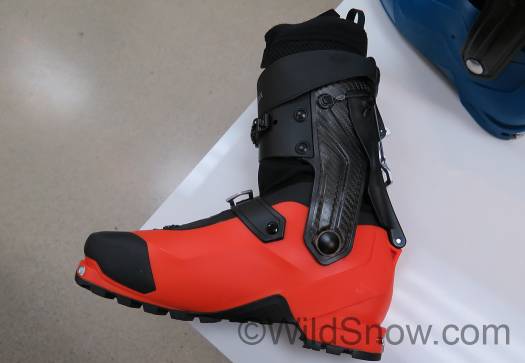
Procline Carbon ski alpinism boot. Let me count the ways. Use of ‘old’ style tech fittings for more sole rubber under sole. Check. Built in zipper gaiter. Check. Grip rubber over toe to hold crampon straps or help with rock climbing. Check. Velcro free power strap. Check. Webbing laced liner. Check. Grilamid plastic scaffo, Grilamid-carbon fiber cuff. Check. More later, gotta go eat some dinner.
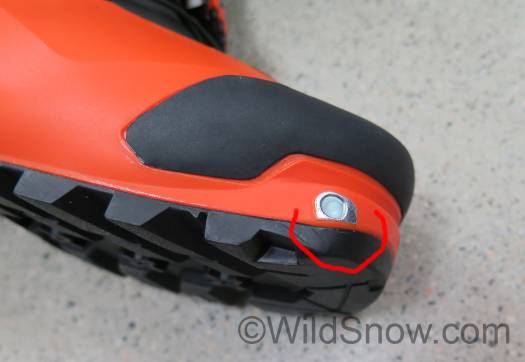
This is a boot that is intended to climb and rock scramble, so they put as much rubber as possible under the old style tech fittings. According to Federico Sbrissa, “Most tech bindings have something to locate your boot anyway, Power Towers or whatever, so the Quick Step-in type boot fittings are not needed.” I’d tend to agree that in many cases having more sole to wear under the fittings trumps using the larger Quick Step-in fittings. But not always. Depends on end use.
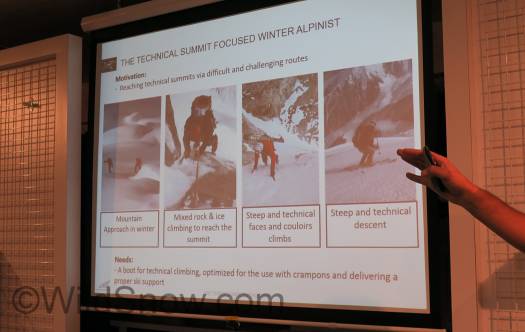
Arcteryx design philosophy for Procline involved the proven method of first finding a need, then filling it. In this case, the need is that of alpinists for a boot that both skis and climbs rock and ice. The rolling side-articulating cuff is the major feature for such, but the built-in gaiter, shorter sole, heavy rocker and low volume contribute to what is indeed a “shoe like” feel. Impressive, really.
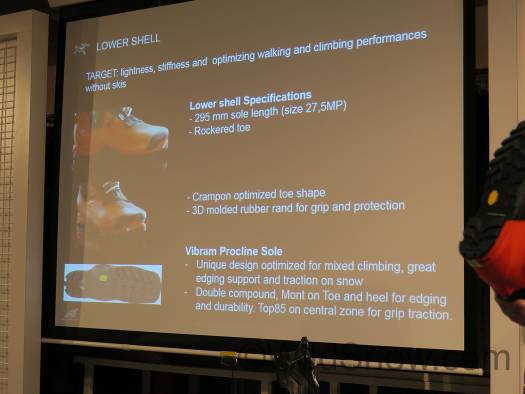
A summary slide from Procline presentation. All well and good, but skiing these over the next few days will tell the honest truth. Nice some samples fit me!
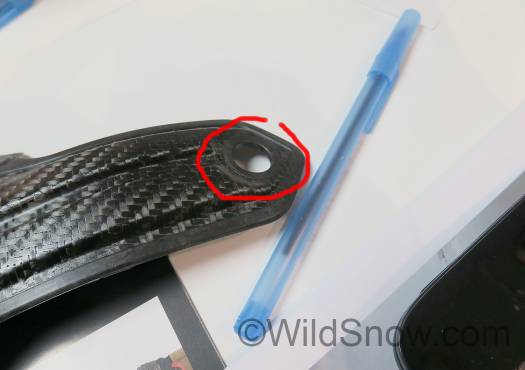
Arcteryx boot designers must have been reading WildSnow dot com, because they addressed a number of our major grips. Pictured here, the carbon boot cuff has a full plastic bushing molded into the pivot point. Without this, the carbon material eats into the lower shell at the pivot point, developing well known slop that’s been the bane of other boot designs with carbon cuffs. Also, Procline has (drum roll) a lower buckle located on top of the instep instead of too the side where it can be opened or damaged by rocks.
Ok, back to the Voltair for a while. I’ve got a pack I’ll be field testing for the next few days up here in Canada, so I’ll file more photos and impressions when that stint is done. Meanwhile, below are more PR screen grabs and such.

I particularly like the simple mechanical handle and trigger system. You lock out by rotating the handle. Arm by rotating back, and trigger with a pull. I’m thinking I’d simply get in the habit of twisting in the unlock direction while pulling, to guard against accidentally leaving the trigger locked.

Centrifugal blower and the snappy harness. The industrial designers on this project went though years of iterations on the blower systems. One guy told me how he’d hooked up the centrifugal fan from a Dirt Devil vacuum cleaner and bumped the RPM up to some ungodly level like 40,000 rpm (why? because he could?), the fan blew apart in his face. Result, disintegrated eyeglasses and a set of stitches on his nose.
Catalog metrics:
Procline Carbon Lite 1190 gr, size 27.5
Procline Carbon Support 1260 gr, size 27.5 (Exact same shell, liner with more ski performance.)
Procline Men’s Lite 1190 gr, size 27.5 (Carbon infused cuff plastic, no fiber.)
Procline Men’s Support 1260 gr, size 27.5 (Infused cuff, liner with more ski performance.)
Procline Women Lite 1060 gr, size 25.5 (Carbon infused cuff plastic, no fiber, sizes from 23 to 27.5, exact same shell as “men’s” with a liner shaped for differences in women’s leg shapes.)
Procline Women Support, 1120 gr size 25.5 (Same as above with ski support liner.)
Voltair rucksack 20 liter, 3235 gr, 7.1 lbs (Both Voltair models have surprising cargo volume.)
Voltair rucksack 30 liter, 3465 gr, 7.6 lbs
Voltaier available for purchase fall 2016, 20L – US $1,650, 30L – US $1,700
Offical press release, edited and condensed by WildSnow.com:
ARC’TERYX ADVANCES AVALANCHE AIRBAG TECHNOLOGY WITH NEW VOLTAIR
…ARC’TERYX proudly debuts its Voltair avalanche airbag, an advanced airbag backpack technology designed to keep skiers and riders at the snow’s surface during an avalanche event, reducing burial. Unlike traditional compressed air cylinder airbag systems that are limited to one deployment per charged cylinder, the ARC’TERYX Voltair airbag system is powered by a heavy-duty 22.2V Lithium-Ion Polymer rechargeable battery…
“Along with routine testing of the system, the multiple deployment advantage allows backcountry skiers and riders to practice deploying the airbag to better train themselves on how to react during an avalanche. In high consequence situation, you don’t rise to the occasion, you fall back on your training,” said (designer) Gordon Rose.
Utilizing an advanced engineered centrifugal blower to fill the 150 Liter balloon, the Voltair system delivers more initial pressure than any other battery powered avalanche airbag system on the market. This superior system ensures the balloon deploys rapidly, consistently and continuously – even if small tears or punctures result from colliding with hard objects like trees and rocks. Another exclusive advantage of the Voltair’s rechargeable battery is its high-grade automotive quick connector for convenient assembly of the system, while also allowing for the ability to disconnect the battery completely from the backpack in order to meet air transportation safety regulations.
Rose: “The Voltair’s sophisticated battery system is extremely robust and is also field rechargeable with a special adapter for portable power sources, solar panels, wind turbines, etc.”
Made in Canada at ARC’TERYX’s own advanced manufacturing facility, other innovative features that set the Voltair airbag apart include its unique mechanical ‘always available’ trigger handle that is permanently accessible and can be quickly unlocked to deploy the airbag during descent. Using proven designs from its award-winning climbing harness technology, the Voltair employs an easy-to-use, one-handed wire gate leg loop/harness system that solidly secures the airbag to the body. Available in 20L and 30L volume, the fully seam-sealed Voltair is constructed with waterproof N400r-AC² nylon 6 ripstop body fabric with WaterTight™ zippers for top
and side access to the two main compartments. Both sizes offer dedicated compartments for additional snow safety equipment like shovels and probes. Front lash ladders and straps diagonally carry skis or snowboard while ice/mountaineering tool loops keep everything else in place for a stable and safe ride.
Product photos provided by Arcteryx:
First look snapshots in the field:
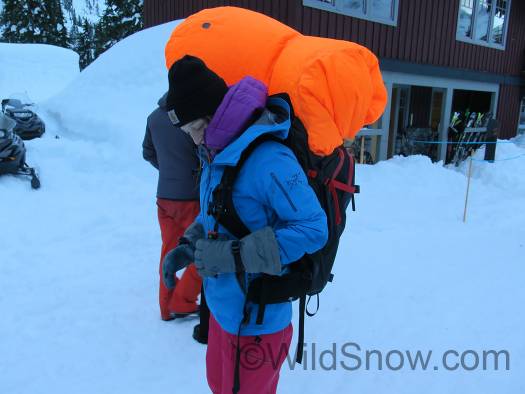
System can continue to fill itself even with small tears or punctures that could occur during an avalanche. Waterproof, taped AC2 pack for weather protection.
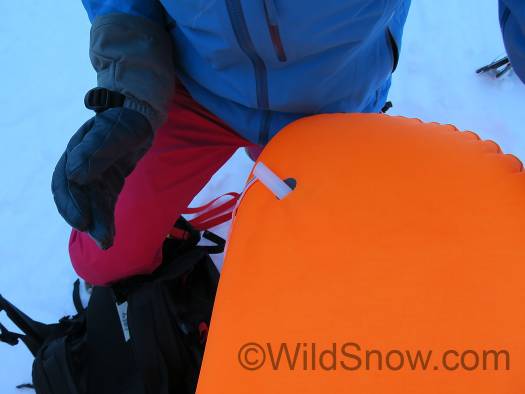
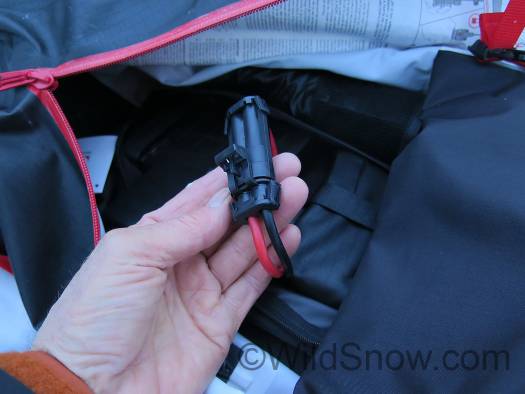
Voltair’s rechargeable battery has an automotive quick connector for convenient assembly of the system, while also allowing for the ability to disconnect the battery completely from the backpack in order to meet air transportation safety regulations.
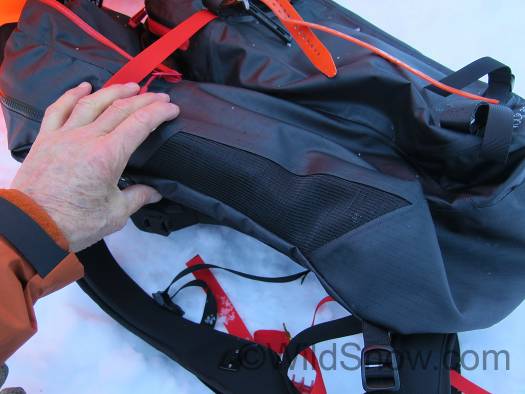
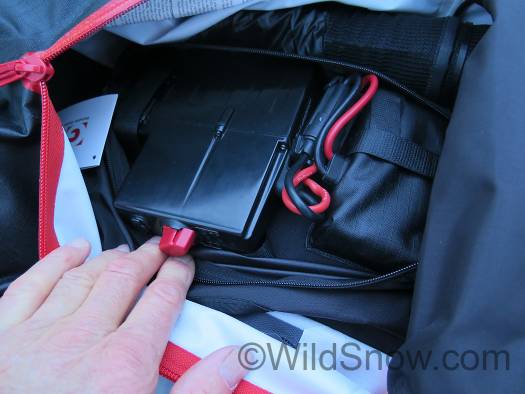
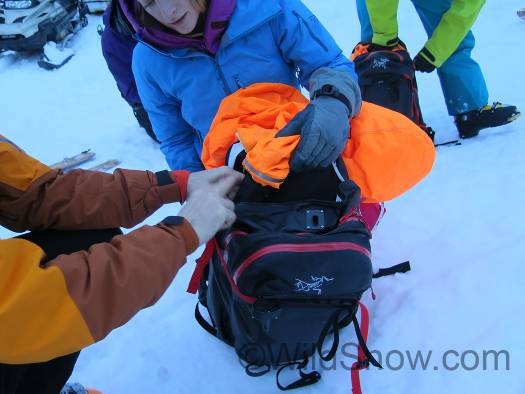
WildSnow.com publisher emeritus and founder Lou (Louis Dawson) has a 50+ years career in climbing, backcountry skiing and ski mountaineering. He was the first person in history to ski down all 54 Colorado 14,000-foot peaks, has authored numerous books about about backcountry skiing, and has skied from the summit of Denali in Alaska, North America’s highest mountain.

